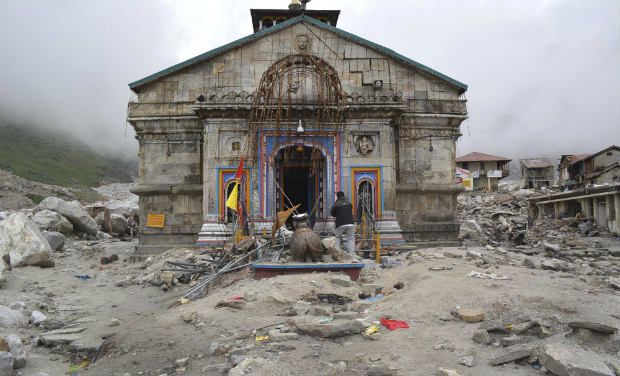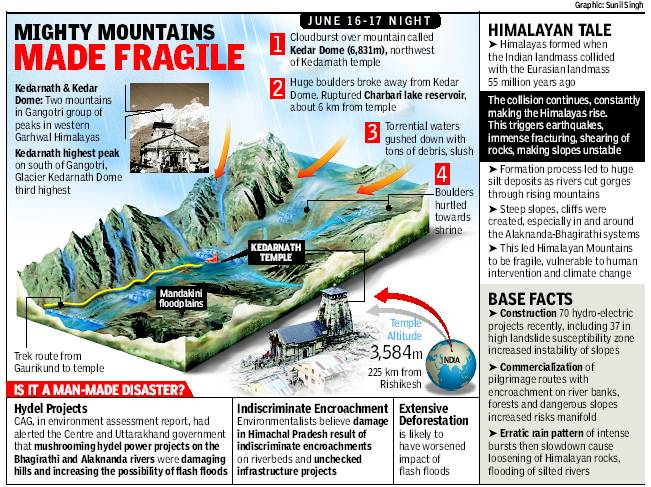Kedarnath
| Line 11: | Line 11: | ||
[[Category:Name|K]] | [[Category:Name|K]] | ||
[[Category:Name|K]] | [[Category:Name|K]] | ||
| − | [[File: | + | [[File: Kedarnath2.jpg|Kedarnath|frame|500px]] |
=General Information= | =General Information= | ||
Revision as of 17:48, 18 December 2013
This is a collection of newspaper articles selected for the excellence of their content. |
Contents |
General Information
Area : 3 sq km.
Season : May to October.
Rainfall : 1475 mm.
Clothing
Summers : Light woollens.
Winters : Very heavy woollens.
Languages : Garhwali, Hindi and English.
Accessibility
Air :
Nearest airport is Jolly Grant, Dehradun, 239 km.
Helicopter Service
Helicopter Service is available from Agastya Muni to Kedarnath (Rudraprayag).
Rail :
Nearest railway station is Rishikesh, 221 km.
Road :
Kedarnath is approachable on foot, 14 km from Gaurikund, which is connected by road with Rishikesh, Kotdwar, Dehradun, Haridwar and other important hill stations of Garhwal and Kumaon hills.
Local Transport :
Horses, dandies and ponies are available at Gaurikund for going and carrying luggage to Kedarnath.
Accommodation
Kedarnath, Ph. No. : 01364-263228.
Information Centre:
Rishikesh (Yatra Office), AGM (Tourism), GMVN Ltd., Tourist Information Centre,
(Advance Reservation Centre)
Shail Vihar, Haridwar By Pass Road, Rishikesh Pin: 249201.
Tel.: 0135-2431793, 2431783, 2432648, 2430799.
Fax: 0135-2430372.
Email: yatra@gmvnl.com, yatraoffice@sancharnet.in.
The place
Amidst the dramatic mountainscapes of the majestic Kedarnath range stands one of the twelve Jyotirlingas of Kedar or Lord Shiva. Lying at an altitude of 3584 m on the head of river Mandakini, the shrine of Kedarnath is amongst the holiest pilgrimages for the Hindus. There are more than 200 shrines dedicated to Lord Shiva in the district itself, the most important one is Kedarnath.
History
According to legend, the Pandavas after having won over the Kauravas in the Kurukshetra war, felt guilty of having killed their own brothers and sought the blessings of Lord Shiva for redemption. He eluded them repeatedly and while fleeing took refuge at Kedarnath in the form of a bull. On being followed he dived into the ground, leaving his hump on the surface. The remaining portions of Lord Shiva appeared at four other places and are worshipped there as his manifestations. The arms appeared at Tungnath, the face at Rudranath, the belly at Madhmaheshwar and his locks (hair) with head at Kalpeshwar. Kedarnath and the four above mentioned shrines are treated as Panch Kedar.
Places to see
An imposing sight, standing in the middle of a wide plateau surrounded by lofty snow covered peaks. The present temple, built in 8th century A.D. by Adi Shankaracharya, stands adjacent to the site of an earlier temple built by the Pandavas. The inner walls of the assembly hall are decorated with figures of various deities and scenes from mythology. Outside the temple door, a large statue of the Nandi Bull stands as guard. Dedicated to Lord Shiva, the exquisitely architectured Kedarnath temple is considered to be more than 1000 years old. Built of extremely large, heavy and evenly cut gray slabs of stones, it evokes wonder as to how these heavy slabs had been handled in the earlier days. The temple has a "Garbha Griha" for worship and a Mandap, apt for assemblies of pilgrims and visitors. A conical rock formation inside the temple is worshipped as Lord Shiva in his Sadashiva form.
The Shri Kedarnath Temple
By Pramod Nautiyal Shri Badrinath-Kedarnath Temples Committee
Location : 14 Km Trek From Gaurikund
Dedicated To : Lord Shiva
Altitude : 3,581 m
Built In : 8th Century AD
Lord Shiva manifested in the form of Jyotirlingam or the cosmic light. Kedarnath is highest among the 12 Jyotirlingas. This ancient and magnificient temple is located in the Rudra Himalaya range. This temple, over a thousand years old is built of massive stone slabs over a large rectangular platform. Ascending through the large gray steps leading to the holy sanctums we find inscriptions in Pali on the steps.
The present temple was built by Adi Shankaracharya.The inner walls of the temple sanctum are adorned with figures of various deities and scenes from mythology. The origin of the revered temple can be found in the great epic - Mahabharata. According to legends, the Pandavas sought the blessings of lord Shiva to atone their sin after the battle of Mahabharata. Lord Shiva eluded them repeatedly and while fleeing took refuge at Kedarnath in the form of a bull. On being followed, he dived into ground leaving behind his hump on the surface.
Outside the temple door a large statue of the Nandi Bull stands as guard. A conical rock formation inside the temple is worshipped as Lord Shiva in his Sadashiva form. The temple, believed to be very ancient, has been continually renovated over the centuries. It is situated at an altitude of 3,581 mt. It is a 14 km trek from Gaurikund.
At the approach of winters in the month of November, the holy statue of Lord Shiva, is carried down from Kedarnath to Ukhimath, and is reinstated at Kedarnath, in the first week of May. It is at this time, that the doors of the temple are thrown open to pilgrims, who flock from all parts of India, for a holy pilgrimage. The shrine closes on the first day of Kartik (Oct-Nov) and reopens in Vaishakh (Apr-May) every year. During its closure the shrine is submerged in snow and worship is performed at Ukhimath.
Location
Kedarnath is amongst the holiest pilgrimages for the devout Hindu. It is set amidst the stunning mountainscape of the Garhwal Himalayas at the head of the Mandakini River. Kedar is another name of lord Shiva, the protector and the destroyer. Shiva is considered the embodiment of all passions - love, hatred, fear, death and mysticism which are expressed through his various forms.
The shrine of Kedarnath is very scenically placed, and is surrounded by lofty, snow - covered mountains, and during summer grassy meadows covering the valleys. Immediately behind the temple, is the high Keadardome peak, which can be sighted from great distances. The sight of the temple and the peak with its perpetual snows is simply enthralling.
The Mythological Past
There are more than 200 shrines dedicated to Lord Shiva in Chamoli district itself, the most important one is Kedarnath. According to legend, the Pandavas after having won over the Kauravas in the Kurukshetra war, felt guilty of having killed their own Kith and Kin and sought the blessings of Lord Shiva for redemption. He eluded them repeatedly and while fleeing took refuge at Kedarnath in the form of a bull.
On being followed he dived into the ground, leaving his hump on the surface. The remaining portions of Lord Shiva appeared at four other places and are worshipped there as his manifestations.
The arms appeared at Tungnath, the face at Rudranath, the belly at Madmaheshwar and his locks (hair) with head at Kalpeshwar. Kedarnath and the four above mentioned shrines are treated as Panch Kedar.
An imposing sight, standing in the middle of a wide plateau surrounded by lofty snow covered peaks. The present temple, built in 8th century A.D. by Adi Shankaracharya, stands adjacent to the site of an earlier temple built by the Pandavas. The inner walls of the assembly hall are decorated with figures of various deities and scenes from mythology. Outside the temple door a large statue of the Nandi Bull stands as guard.
Dedicated to Lord Shiva, the exquisitely architectured Kedarnath temple is considered to be more than 1000 years old. Built of extremely large, heavy and evenly cut grey slabs of stones, it evokes wonder as to how these heavy slabs had been handled in the earlier days. The temple has a Garbha Griha for worship and a Mandap, apt for assemblies of pilgrims and visitors. A conical rock formation inside the temple is worshipped as Lord Shiva in his Sadashiva form.
Best Time to visit:
The ideal time or peak season to go for a Char Dham Yatra is from May to October, except monsoons. This is because; all the four sacred sites are perched in Garhwal Himalayas, which is prone to heavy snowfall. As a result, all the passage leading to the shrines are blocked. Moreover, during the monsoon season, there is undue threat of having landslides, which can further disrupt the journey.
Kapat Closing:- The kapat [doors] of the Shri Kedarnath Temple were closed in 2013on the 5th Nov.
Kedarnath: climate/ cloudbursts
Cloudburst on Kedar Dome no freak event
TIMES NEWS NETWORK
New Delhi: The June 16, 2013 cloudburst over Kedarnath, or to be exact over the mountain peak called Kedar Dome which stands at 6,831m,cannot be called a freak climatic phenomenon. Since 1998,the frequency of such heavy, concentrated rainfall over a short period has increased. Ukhimath witnessed the phenomenon in 1998,followed by a series of such events in 2002 in Phata in Mandakini Valley,Khedgaon in Kumaon,and Agunda in Bhilangar Valley.In 2003,Tehri,too,saw such abnormally high rainfall,as did Ladakh in 2010 which triggered mudslides leading to 255 deaths.
While cloudbursts are a natural hazard, our approach to development increases our vulnerability to hazards, said Dr Anirudh Uniyal,a scientist at Remote Sensing Application Centre, Lucknow.The real reason behind the catastrophe was overloading of the hill slopes with built structures. Until a few decades ago, a visit to Kedarnath was considered hazardous enough for people to start for the pilgrimage early morning and return by late afternoon, said Uniyal.
Temple unscathed by 2013 cloudburst tragedy
Shrine statues,Nandi still intact
Devastated by June 16, 2013 afternoons flash-floods,’Kedarnath town stands virtually razed but for the 1200-year-old Shiva temple built by Adi Shankaracharya. The shrine stands in six feet of debris. The statues and the lingam inside the shrine, as well as that of his mount, Nandi the bull, adorning the 250ft x70ft courtyard, are intact.Call it a miracle, but the Nandi statue and the other idols in the temple are intact, an official told news agencies here, adding that pilgrims who were inside the temple when the cloud burst took place had survived.
The idols
Priest takes Kedar idol to winter home
Yogesh Kumar | TNN
A Kedarnath temple priest kept tradition alive. Lord Shiva’s revered symbol at Kedarnath, the “bhog murti” must be fed daily in what’s called the akhand puja (unbroken worship).
Every winter, the idol is moved to Omkareshwar temple in Ukhimath and returned to Kedarnath in May. Seeing no other option but to carry the idol to its winter abode,
The return of Dhara Devi
Locals believed that the removal of the idol on June 17 [??] 2013 by officials of the Alaknanda Hydropower Co was the trigger for the 2013 disaster. The idol has been brought back and is housed on an elevated temple. Dhari Devi’s idol was returned immediately after the disaster, on June 25. AGENCIES
2013: Faith reinforced
Flash floods can’t sweep away their faith in God
Bella Jaisinghani | TNN 2013/06/23
Much less than shaking people’s belief the Uttarakhand tragedy has reinforced their faith in the twin forces of Shiva and Shakti. Believers insist that nothing remains intact in Kedarnath save the shrine. The shivling remains crowned by offerings of belpatra.
Devotees blame the dis aster on the fact that the statue of Goddess Kali Dhari Devi in Kedarnath guardian deity of Uttara khand, was removed from her temple a day before the cloudburst. The shrine was being shifted for a hydel power project that now lies in ruins. A similar attempt in 1882 had resulted in landslide that had flattened Kedarnath.

